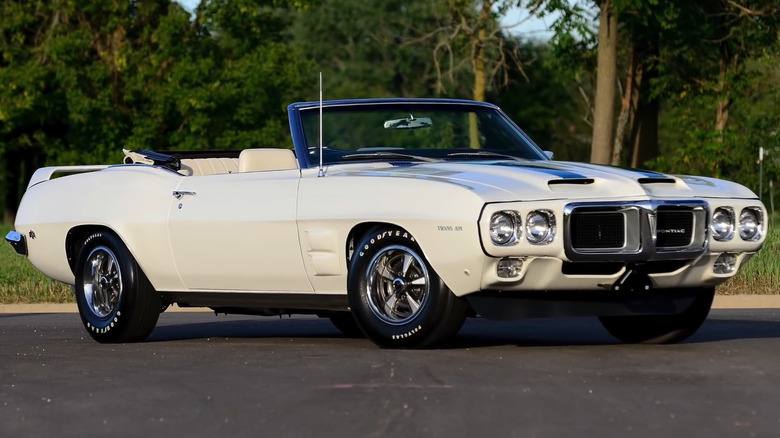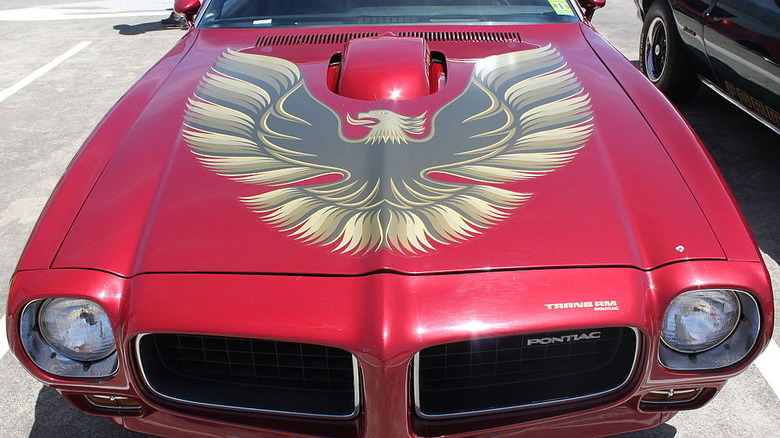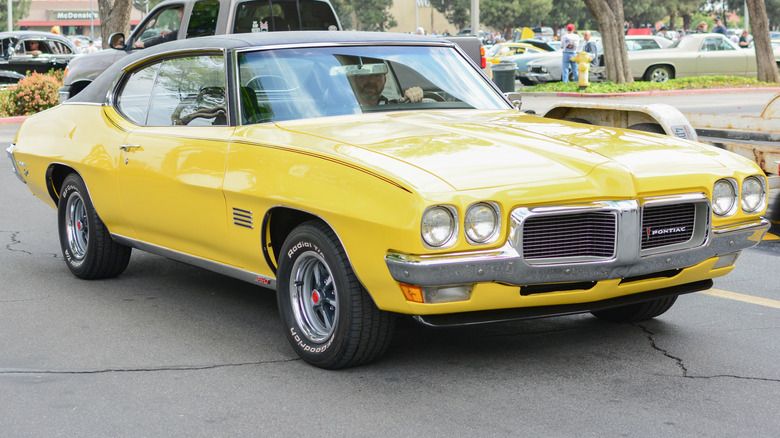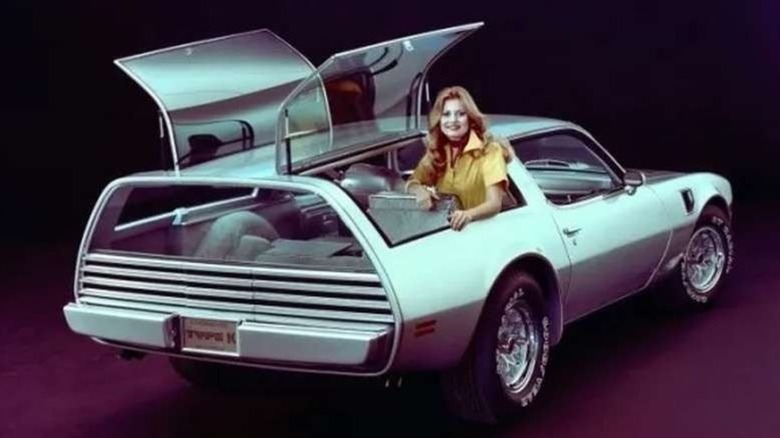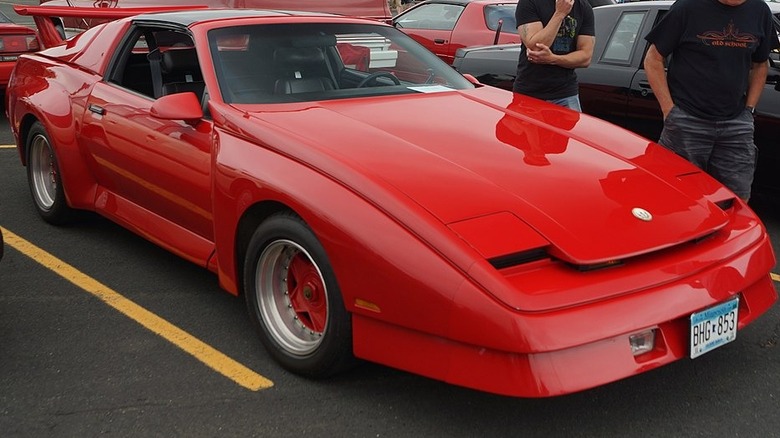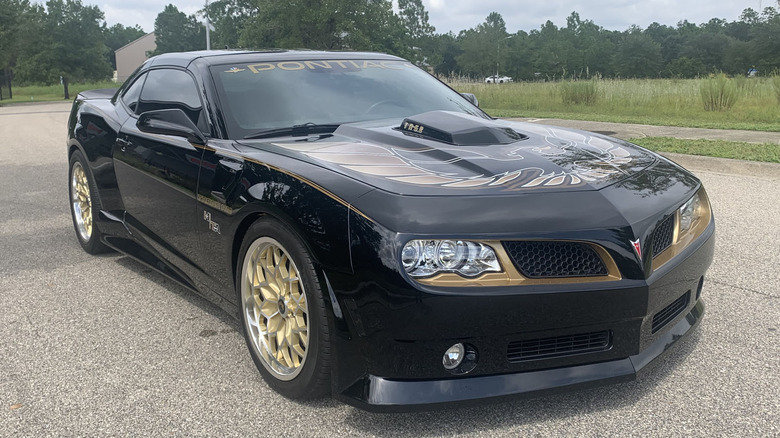10 Fun Firebird Facts Every Pontiac Enthusiast Should Know
The Pontiac Firebird will likely go down in history as one of the most beloved cars of the 20th century. It first appeared during the 1967 model year alongside the Camaro as part of a two-pronged takedown of the wildly popular Ford Mustang. However, the effort may not have worked in the long term. The Mustang is going strong in its seventh generation of continuous production, but the Firebird cemented its place in muscle history over a 35-year period spanning four generations before getting the axe.
That's not bad for a car that almost didn't see the light of day. The Firebird's tenure ended in 2002, followed by maker Pontiac itself seven years later. Fan love for the nameplate runs deep among enthusiasts today, including some surprising information about a modern Trans Am that has risen from the ashes like its namesake phoenix.
Join us as we dive into ten fun facts every Pontiac enthusiast should know about the mighty Firebird.
The car that almost wasn't
In 1965, Pontiac had a bold plan for a potent new nameplate to be named after a mythical creature. You might think it was the Firebird, and you'd be partly correct — but there was another.
Ford kickstarted a revolution halfway through the 1964 model year with the introduction of the Mustang. Lighter and more economical than mid-sized muscle cars like the GTO and Chevelle, the Mustang caught General Motors flat-footed.
Determined to develop its own pony cars to chase down the galloping Mustang, executives decreed that Pontiac build its own. However, ill-fated Pontiac executive John Delorean — known for his role in developing the legendary GTO — had another plan in mind. The mind behind the GTO didn't want to compete with Mustang, he wanted to build a sports car. The XP-833 concept, later known as the Pontiac Banshee, had already taken physical form. Delorean was a key figure in pushing for the Banshee's production.
One major problem arose. The proposed Banshee wouldn't be elbowing for room in the market with the Mustang. It would likely attract buyers of General Motors' king of the performance pile, the Chevrolet Corvette. Competing with itself didn't make sense (which General Motors belatedly realized by killing all but four major brands), and the Banshee didn't get beyond the prototype stage. Still, every time someone loses, someone else wins. Legions of future Firebird fans got the inaugural edition in 1967.
The most valuable Firebird in the world is a 1969 convertible.
Muscle cars have demanded a premium on the used market for several years, but some stand above the rest. Whether due to originality, rarity, or limited edition options, exorbitant prices dot the used muscle landscape. For the Firebird, the 1969 Trans Am convertible stands above the rest in value.
Named after the Trans American Cup series of road racing, the first Firebird Trans Am Performance and Appearance Package was introduced in 1969 as a high-performance upgrade option. For $725 – about $6,000 in 2024 — the Trans Am received an upgraded suspension, power steering, and Pontiac's high-output 400 cubic inch, 335 horsepower V8 engine. Consumers had a single paint option: Polar White with blue racing stripes.
Pontiac did little advertising for the Trans Am, resulting in only 705 total 1969 Trans Am packages out of the total production of over 87,000 Firebirds that year. Any true 1969 Trans Am is rare, but the crown jewel is the convertible — of which only eight were built. Since 1969 was also the last year of the first-generation Firebird, these rarest of the rare Trans Ams are the only first-gen convertibles in existence.
A first-generation Trans Am demands an average of $136,000 on the used market, but the cream of the crop convertible –- if you can find one for sale -– demands upwards of $1 million.
The iconic decal first went on a 1973 Firebird.
Early 1970s car design was anything but subtle, and Pontiac showed a particular penchant for adding ripples, trim pieces, and other cosmetic flair not present in the Firebird's near-twin Camaro.
The most enduring example is the famed decal Pontiac emblazoned across Firebird hoods beginning in 1973. Lovingly (and deridingly) referred to as the Screaming Chicken, the phoenix decal represents a certain tire-smoking, Zeppelin on the FM, Smokey and the Bandit middle finger to authority, the Chevy bow tie, and anyone else who happens to be in the vicinity.
Pontiac head of design Bill Porter scrawled a doodle of the idea during his lunch break after seeing a Tiffany vase with a design reminiscent of outstretched wings. He handed the sketch off to graphic designer Norm Inouye, who expanded on it, ultimately placing it on a clay model for the new second-gen Firebird in development. GM design head Bill Mitchell happened to catch a glimpse and instantly despised it.
A couple of years later, designer John Schinella resolved to change Mitchell's mind. Affixing a gold decal to a black Firebird and parking it next to Mitchell's black and gold motorcycle in the parking lot, he had Mitchell look out the window. It was enough to convince Mitchell to give it the green light. The decal first appeared as an option on the 1973 Firebird, and the rest was history.
[Featured image by Jeremy via Wikimedia Commons | Cropped and scaled | CC BY 2.0]
Smokey and the Bandit was responsible for skyrocketing Firebird sales.
Hollywood and automakers have long enjoyed a symbiotic relationship. After all, placing a vehicle into a major motion picture gives a new meaning to the term star vehicle. Some cars, like James Bond's first Aston Martin DB5, become as famous as the fictional character they ferry around. Others, like the Eleanor Mustang from Gone in 60 Seconds, are integral to the plot.
The Firebird's big break came in 1977's action comedy Smokey and the Bandit, in which Burt Reynolds is tasked with smuggling Coors beer across the Mississippi (then illegal). To distract the police from the loaded 18-wheeler, Reynolds employs a 1977 Pontiac Trans Am replete with T-Tops and screaming chicken decal.
The actual movie car was a gussied-up '76 Firebird with the upcoming 1977 front end added on. Highway hijinks ensued, and the Trans Am took its place in cinema history. Pontiac must have been ecstatic with the roles of its star, especially considering how it manifested in sales the following year.
A year after Burt Reynold's bootlegger blockbuster, Pontiac sold 25,000 more Trans Ams than originally anticipated. If a 1973 black-and-gold Trans Am with the decal convinced Bill Mitchell there was merit to the design, the movie version convinced the rest of America. Pontiac saw the best-selling Firebird and Trans-Am year of all time in 1979.
Firebirds had engines built by Chevrolet, Oldsmobile, and Buick.
General Motors served as an umbrella corporation for several car brands, which meant that sharing technologies between brands was not uncommon. Buick was amongst the first brands to share its V8 engines, and Cadillac's high-performance models sourced Corvette engines for the early iterations of the V-badge. So while you might expect a nameplate as iconic as Firebird to stick with Pontiac engines, that wasn't always the case.
For instance, at one point the Firebird could be equipped with an Oldsmobile 403-cubic-inch V8 making 185 horsepower. This powertrain was available in the 1977 Firebird and was specifically developed for high-altitude markets and emissions-friendly California.
Pontiac also looked to a fraternal brand for the second-generation Firebird. With the fuel and emissions crises of the 1970s gutting the muscle market, from 1970 to 1976, Firebirds got a Chevrolet engine. The 250 cubic-inch straight-six cylinder engine underwent decreasing power to meet regulatory standards. From 155 hp in 1970 to 100 hp in 1976, they are an interesting footnote in Firebird history, if not particularly desirable in the used market.
Perhaps more inspiring, the third-generation 1989 Trans Am used as the pace car for the 20th running of the Indianapolis 500 also used a six-cylinder. Rather than a gas-sipping straight six, the pace car got the turbocharged 3.8-liter V6 from Buick's vaunted Grand National and GNX. Making 250 horsepower, it might not stack up to the fire-breathing Trans Ams of 1969 and 1970, but it was plenty for 1989.
The Firebird Sprint took inspiration from European sophistication.
While Trans-Am and WS6 Firebirds receive much attention, a lesser-known option was intended to compete with European sports cars. The Firebird Sprint, arriving in the inaugural 1967 model year, predated the Trans Am and was designed with a unique mission that sets it apart from its counterparts.
The original base Firebird employed a straight-six making 165 horsepower, but for an additional $116 (about $1,000 in 2024), consumers could upgrade to the Sprint package. Despite Pontiac's reputation for soul-crushing big-displacement power, the Sprint took a different tack.
Pontiac had been developing a high-performance overhead cam with straight six-cylinders similar to those in European road racing. Delorean's documented dedication to high-tech sports cars might have failed the Banshee, but its legacy became the Firebird in the form of an engine inspired by European racing.
The 1967 Pontiac Firebird Sprint made 215 horsepower — a significant bump from the base 165 — via a 265 cubic-inch straight-six. The extra power came from a sophisticated overhead cam design run by one of the earliest timing belt setups. The fiberglass-reinforced belt was lighter and made less noise than the typical timing chain.
Delorean initially wanted the engine to power the Banshee, but it ended up in the Sprint instead. Pontiac only built the Sprint between 1966 and 1969, and its rarity and historical value make it a collector's favorite today.
The Type K was a wild station wagon Firebird.
Sport wagons occupy a celebrated niche in car culture, but few know that Pontiac dabbled in building one based on the second-generation Firebird. The 1977 to 1979 Firebird Type K was a two-door wagon prototype that became the rarest Firebird ever.
Sketched out by General Motors designer Gerry Brochstein, the Type K featured an elongated rear end that cuts off in an aerodynamic-friendly Kamm tail design (hence the Type K moniker). General Motors felt good enough about the design to commission famed Italian coach-builder Pininfarina to drum up a pair of steel-bodied prototypes.
The resulting Type Ks were born as 1978 models. They employed a pair of gull-wing glass windows to access the rear storage. Under the hood decal was an Oldsmobile 403 cubic-inch V8, making 185 horsepower.
Only two were ever built. They toured the country, appearing at car shows, but cost-efficacy studies indicated that putting the K-type in full production would require an MSRP of $25,000 — at a time when the 1978 Trans Am demanded $5,799. This significant price difference, coupled with the limited demand for a two-door wagon, led to the decision not to put the Type K into production.
The Type K never saw production, making it the rarest Firebird of all time. General Motors reportedly destroyed one, but the second crossed the auction block in 2011, selling for $154,000.
The first car to crack 200 miles per hour?
Third-generation Firebirds, built between 1982 and 1992, are infamous for the low-power plague that ravaged the 1980s. The 1985 four-cylinder iteration was the weakest of all time, with a pitiful 88 horsepower. However, there is another end to that spectrum in what may have been the world's first 200 mph production car.
That speed is usually associated with exotic supercars of European descent, but years before the Ferrari F40 stepped into the spotlight, the Pontiac Tojan cracked 200 miles per hour. Pontiac wanted to drum up excitement for the third-gen Firebird, a project that also begat K.I.T.T. from Knight Rider.
Turning away from Hollywood and toward performance, Pontiac contacted Omaha-based Knudsen Automotive to build an out-of-this-world iteration of the Firebird known as the Tojan. Based on a 1984 Trans Am, the Tojan used a Gale Banks-designed powerplant, namely a small-block V8 juiced to the gills and fitted with a pair of turbochargers. The original prototype was the only one to get this 800-horsepower treatment. It catapulted the Tojan into automotive history by reaching speeds up to 206 mph years before the Ferrari F40 that usually gets the credit.
Knudsen eventually sold 136 Tojans between 1984 and 1991, but they were nothing like the record-setting original. The production Tojan engine was usually a 5.0-liter or 5.7-liter that barely cracked 200 horsepower let alone 200 mph. They remain surprisingly affordable to collectors. A 1987 Tojan sold for a mere $20,000 in January 2024.
[Featured image by Greg Gjerdingen via Wikimedia Commons | Cropped and scaled | CC BY 2.0]
The Firebird held the world production land-speed record
The Tojan wasn't the only Firebird to hold a record. Famed hot rodder and engine builder Gale Banks reared his head again in 1987 when his Pontiac Trans Am GTA set a record for the world's fastest passenger car. Though ostensibly a Firebird, a peek under the hood reveals anything but a stock setup. With a stated goal of hitting 300 mph on the Bonneville Salt Flats, Banks and his team seriously souped up a 1988 Firebird. They chose the Firebird for its sleek aerodynamic traits that would support stability at ultra-high speeds. Banks estimated the Firebird would be as stable at 280 mph as 60 mph.
Under the hood, a 454 cubic inch V8 from General Motors' marine division. Banks installed a pair of Garret Indy car turbos, custom intercoolers that required a 90-gallon cooling tank packed with ice in the trunk, and high-performance heads. Boost was set at an initial 25 pounds of pressure, with an anticipated 38 possible for the proposed 300 mph run. Together, the setup made around 2,200 horsepower.
When the moment of truth arrived, the Firebird roared to a staggering top speed high of 283 mph before a blown front tire brought the attempt to an end. While it didn't quite reach its 300 mph target, it still managed to set a record for the fastest stock-bodied gasoline-powered passenger vehicle, with a new land speed set for production vehicles at 268.033.
The Trans Am isn't dead
The Chevrolet Camaro and Pontiac Firebird were in lockstep from 1967 until their discontinuation after the 2002 model year. Despite decades of competition, each car had legions of fans who would swear their choice was superior. They were so similar in appearance, configuration, and application that considering them fraternal twins would be accurate.
The Camaro was reborn in 2009, but by then General Motors had axed the Pontiac line entirely, precluding any chance the Firebird would return. However, the return of the Camaro provided a platform for the Trans Am to live on -– perfect for brothers Scott and Tod Warmack of Tallahassee, Florida.
The pair licensed the Trans Am name from General Motors and set about resurrecting the once-great sports car. Using the new Camaros, Trans Am Worldwide creates modern Trans Ams with all the old-school flair a Pontiac lover could want. They don't come cheap, but they are a gorgeous take on the Trans Am legacy that superfans can own for themselves.
The brothers don't just do Pontiac, either. One of their latest projects is a Chevelle 70/SS concept that brings the legendary muscle car back from the dead. TAW has also used its unique vision to create modern iterations of the Pontiac GTO Judge, the Bandit Trans Am from Smokey and the Bandit, and a Super Duty Trans Am with a supercharged 455 cubic inch engine. So even though the Firebird disappeared from showrooms over 20 years ago, its memory is still going strong.


